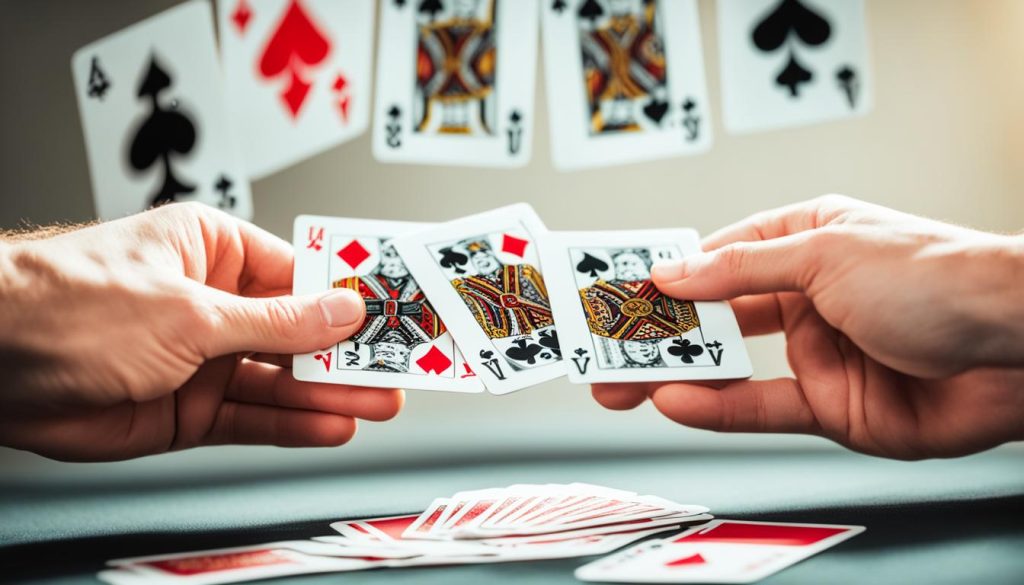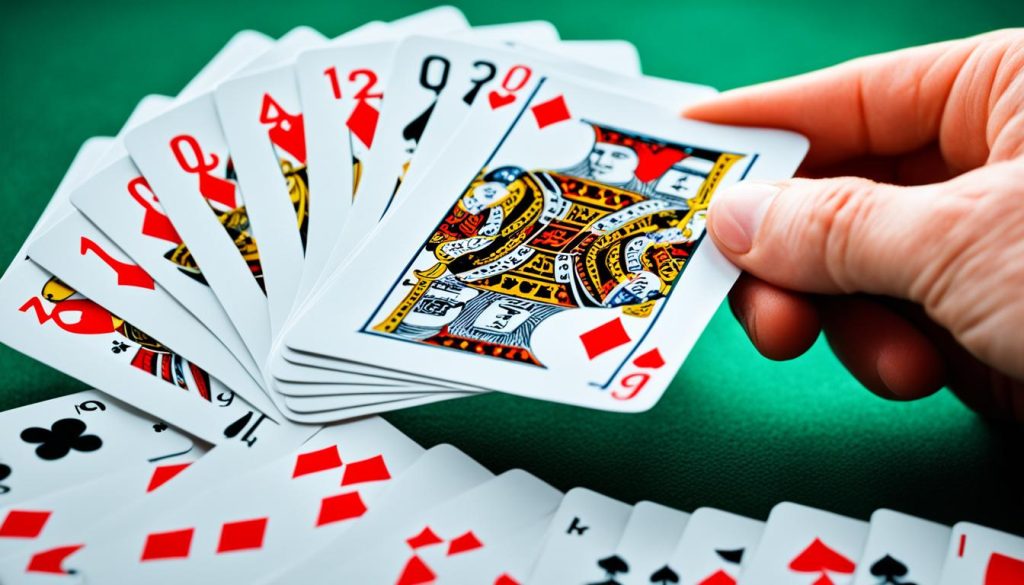Welcome to our guide on how to play Gin Rummy! Whether you’re a beginner or an experienced card player, Gin Rummy is a classic game that offers both excitement and strategic challenges. In this article, we will walk you through the rules, strategies, and tips for mastering this popular card game. So let’s dive in and discover everything you need to know about Gin Rummy!
How to Play Gin Rummy?
Gin Rummy is a 2-player card game that can be played with a standard 52-card deck. The objective of the game is to form sets or runs of cards and earn the highest number of points. Throughout the game, players will engage in melding, picking up cards, discarding cards, and ultimately aiming to achieve the best score. With its simple rules and engaging gameplay, Gin Rummy is suitable for players of all skill levels and its different from playing the traditional rummy.
Setting up the Game
Before diving into the thrilling game of gin rummy, it’s important to set up the game correctly to ensure a fair and enjoyable experience. Here’s how you can get started:
1. Number of Players: Gin rummy is best played with two players, but if you have a third person, they can act as the dealer.
2. The Deck: To play gin rummy, you’ll need a standard 52-card deck. Remove any Jokers from the deck before starting.
3. Determination of the Dealer: Have each player draw a card from the deck. The player with the lowest card becomes the dealer.
4. Card Distribution: The dealer should distribute ten cards to each player, alternating between them until all cards have been dealt.
5. Stock Pile: Set up the stock pile by placing the remaining cards face-down on the table.
6. Discard Pile: The dealer draws one card from the stock pile and places it face-up next to the stock pile to start the discard pile.

Gin Rummy Gameplay
Now that you have set up the game, it’s time to dive into the exciting world of Gin Rummy. In this section, we will explore the gameplay mechanics and strategies that will help you become a skilled player.
Sorting Your Cards into Melds
The first step in playing Gin Rummy is to sort your cards into melds. A meld can be either a set of three or four cards of the same rank, or a run of three or more consecutive cards in the same suit. Sorting your cards into melds will help you visualize your potential winning combinations and make better decisions throughout the game.
For example, let’s say you have the 2♦, 3♦, and 4♦ cards. You can create a run by adding the 5♦ or complete a set by adding another card of the same rank, like the 4♥ or 4♠. This strategic thinking is crucial for maximizing your chances of winning.
Picking Up and Discarding Cards
During your turn, you have the option to either pick up the top card from the discard pile or draw from the stock pile. Consider your melds and determine which card will benefit your strategy the most.
For example, if you have a set of three 8s and you notice that your opponent just discarded an 8, it may be advantageous to pick up that card and complete your set. On the other hand, if you are close to forming a run and the stock pile offers a card that can extend it, you may choose to draw from there instead.
After you have picked up a card, assess its usefulness. If it fits well with your melds, keep it and decide which card to discard. If not, discard a card that won’t be of value to your opponents and place it face-up on the discard pile.
The Goals: Going Gin and Knocking
The ultimate goal in Gin Rummy is to either go gin or knock, signaling the end of the round. Going gin means that you have formed all your cards into melds, leaving no unmatched cards. By going gin, you earn 25 bonus points plus the opponent’s deadwood points. This can be a game-changing move that catapults you to victory.
If you don’t go gin, you can opt to knock when you have less than 10 points of unmatched cards. When you knock, both you and your opponent expose your melds, and the opponent has the opportunity to lay off any of their unmatched cards onto your melds. This can reduce your opponents’ deadwood points and potentially boost your chances of winning the round.
It’s important to note that knocking before your opponent has the opportunity to go gin can prevent them from earning bonus points. However, knocking should be carefully considered based on your current hand since it may give your opponent a chance to decrease their deadwood points.

Continue taking turns picking up cards, discarding cards, and aiming for gin or knocking until a round winner emerges. The player with the lower deadwood score after knocking wins the round.
| Scoring the Round | Points Earned |
|---|---|
| Going Gin | 25 bonus points plus opponent’s deadwood points |
| Knocking | Difference in deadwood scores |
Now that you have a grasp of the gameplay mechanics, let’s move on to scoring and winning strategies in the next section.
Scoring and Winning
In Gin Rummy, scoring is an essential aspect of determining the winner. By understanding the intricacies of scoring, players can strategically plan their moves to maximize their points and increase their chances of winning.
Points Calculation
The scoring in Gin Rummy is based on the value of unmatched cards in a player’s hand. Each card carries a specific point value, as shown in the table below:
| Card | Point Value |
|---|---|
| Ace, King, Queen, Jack | 10 points each |
| Numbered Cards | Face value (e.g., 5 of hearts = 5 points) |
Players accumulate points based on the value of the unmatched cards and strive to minimize their score with skilled gameplay.
Gin and Knock
If a player manages to arrange all their cards into melds (sets or runs) without any unmatched cards, they go gin. Going gin rewards the player with 25 points plus the opponent’s deadwood points. This achievement requires strategic planning and careful observation of the opponent’s moves.
Alternatively, if a player feels they have formed enough melds and has fewer than 10 points of unmatched cards, they can choose to knock. Upon knocking, both players reveal their melded cards, and the player with the lower deadwood score wins the round. The winning player receives the difference in points between their scores as a reward.
Undercut and Shutout
An undercut occurs when the player who knocked has a higher deadwood score than their opponent. In this situation, the opponent receives the difference in points plus a 25-point bonus. It adds an element of risk to knocking, as the opponent has the opportunity to turn the game around and secure a higher score.
A shutout is a remarkable achievement in Gin Rummy. It occurs when one player wins every round, resulting in a complete victory over their opponent. A shutout earns the victorious player an additional 100 bonus points, further solidifying their dominance.
Winning Conditions
A game of Gin Rummy continues until one player reaches either 100 or 250 points, depending on the desired game length. The player with the highest score at the end of the game emerges as the winner, showcasing their mastery of strategic gameplay and scoring tactics.
Note: The point values mentioned in this section are subject to variation based on different variations of Gin Rummy.
Tips and Strategies
When it comes to playing gin rummy, having some helpful tips and effective strategies can give you an edge over your opponents. Here are some techniques to improve your gin rummy gameplay:
- Memorize cards being discarded and picked up by your opponent to deduce their sets and runs. This can give you valuable insight into their hand and help you anticipate their next moves.
- Aim for runs over sets, as runs can be expanded on both ends. By focusing on runs, you increase your chances of forming longer sequences, earning more points, and reducing your deadwood count.
- Knock as early as possible if you have less than 10 points of unmatched cards. This strategy allows you to minimize the points in your hand and put the pressure on your opponent to complete their melds quickly.
- Observe the cards being discarded to avoid collecting cards that your opponent may need. By paying attention to the cards they are discarding, you can adjust your strategy accordingly and disrupt their hand.
- Keep track of the cards your opponent needs to prevent them from completing their melds. This information can guide your own discards, enabling you to retain cards that are crucial to your opponent’s potential melds.

With these gin rummy tips and strategies, you’ll be on your way to becoming a skilled player. Remember to adapt your tactics based on the gameplay and always stay one step ahead of your opponents. Good luck and enjoy the game!
Conclusion
Gin rummy is an enjoyable card game that requires strategy and skill. By following the rules and implementing smart tactics, players can improve their chances of winning. It is crucial to pay attention to the cards being played and plan your moves accordingly to create successful melds. With practice and experience, players can develop their skills and become skilled gin rummy players.
Remember, the key to winning in gin rummy is to form melds and minimize the number of unmatched cards in your hand. Carefully observe your opponent’s moves and anticipate their next move to prevent them from completing their melds. Building runs rather than sets can provide more flexibility in expanding your melds. When necessary, knocking early with a lower deadwood score can secure your victory.
FAQ
Is Gin Rummy 7 or 10 Cards?
While traditional gin rummy is played with 10 cards, there are variations that use only 7 or even up to 13 cards. However, in the UK, the most commonly played version of gin rummy uses 10 cards.
How to Play Rummy UK With 2 Players?
Playing gin rummy in the UK with 2 players is a fun and engaging game that requires strategy, skill, and a bit of luck. To start, each player is dealt 10 cards from a standard deck of cards. The remaining deck is placed face down on the table, with one card turned face up next to it to begin the discard pile. The goal of the game is to form melds (sets or runs) with your hand and be the first player to get rid of all your cards.
Is There a Difference Between Gin and Gin Rummy?
While both Gin and Gin Rummy are card games that involve creating sets or runs of cards, there are some key differences between the two. First, gin is typically played with a standard deck of 52 cards, while Gin Rummy uses two decks for a total of 104 cards. Additionally, in gin, players have the option to knock and end the round early if they think their hand has a lower value than their opponent’s. In Gin Rummy, there is no knocking, and players must play all of their cards until they can form a meld or lay off all remaining cards.
Is Gin Rummy Hard?
While the rules of Gin Rummy may seem intimidating at first, it is not a difficult game to learn. With a little bit of practice and strategy, anyone can become a skilled player. The key is to pay attention to your opponent’s moves and make calculated decisions with your own cards.






